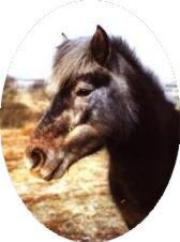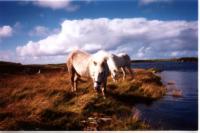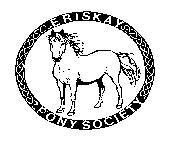|
|
| The
Eriskay Pony |
 |
History & Origins The Eriskay Pony is the last survivor of the native
ponies of the Western Isles of Scotland. Its origins are ancient, certainly
with Celtic and Norse connections. Although numerous in previous centuries,
numbers decreased dramatically around the beginning of 19th century.
Eventually, only a handful remained on the small island of Eriskay, which lies
between South Uist and Barra in the Outer Hebrides. The last survivors of this
ancient breed have become inextricably identified with this tiny island, hence
the name Eriskay Pony.
 |
On Eriskay the
crofters continued to use their ponies for the traditional tasks of carrying
peat and seaweed in panniers slung in pairs across the ponies' blacks. The
ponies were handled mainly by women and children whilst the menfolk were away
at sea in their fishing boats. |
Modern Eriskay ponies are the last surviving
remnants of the original native ponies of the Western Isles of Scotland. Recent
DNA testing by the University of Leicester has proven that they are a distinct,
primitive breed, with ancient origins. Certainly they have ancient Celtic and
Norse connections and Eriskays have been proven by measurement to be of similar
proportions to those found on ancient Pictish stones throughout the North and
West of Scotland.
Until the middle of the 19th Century ponies of
the “Western Isles type” were found throughout the islands and used
as crofters ponies, undertaking everyday tasks such as bringing home peat and
seaweed in basketwork creels slung over their backs, pulling carts, harrowing
and even taking the children to school.
| In some ways the
ponies were subject to “human” in addition to “natural”
selection. The ponies had evolved to survive on meagre food supplies, with
coats, ears and tails well adapted to coping with a harsh, wet and windy
climate. Eriskays were then subject to the forces of living in a society where
women and children did most of the work while the men were at sea. Poor
temperaments could not be tolerated. Only those ponies happy to live in close
proximity with their handlers, those willing to be trained and work hard, were
retained. Unsuitable specimens were culled |
 |
Over the centuries, the Eriskay ponies evolved
into the hardy, versatile, people friendly characters we recognise
today.
On many of the islands increasing mobility and
farming pressures led to larger ponies becoming fashionable. Norwegian Fijords,
Arabs, Clydesdales and others were introduced to “improve” the native
stocks and produce larger, stronger animals. On the remote island of Eriskay in
the Western Isles, however, due to difficulties with access, other breeds were
not introduced, leaving a stock of pure bred ponies which had declined to a
around 20 animals, due to mechanisation, by the early 1970s.
The Modern Eriskay
Today, Eriskay Ponies can been seen competing
in all spheres of equestriansm. Members of the Eriskay Pony Society regularly
take part in activities such as dressage, jumping, cross country, pony club
eventing, team games, western riding and driving. Although they stand between
12.0 and 13.2hh they are strong for their size, have terrific stamina and can
carry a light adult with ease. They also make excellent driving ponies, Lesley
Cox from Cheshire has had tremendous success with her tandem driving ponies,
competing at FEI level and winning regularly.
Other Eriskays find excellent homes as family
ponies, with their human friendly characteristics coming to the fore playing
football in the garden with the kids, or working with special needs children as
RDA ponies.
Eriskay ponies are very distinctive in that
they are usually born black or bay and usually turn grey as they mature, a few
individuals have remained black or bay into adulthood, but no other colours
occur.
They have a dense,
waterproof, but not overly long, coat which enables them to live out in the
harshest of conditions, and have a little, light feathering on their fine legs.
The head is sensible and workmanlike with plenty of room for air to warm in the
sinuses before it reaches the lungs, and the tail is low set to keep the hind
end warm in the wind and rain. |
 |
DESCRIPTION OF THE
BREED
The Eriskay Pony stands 12.0 - 13.2 hands
high.
The predominant colour is grey, with the
occasional black or bay.
Though fouls are often born brown or black they
turn grey with maturity.
In winter a dense waterproof coat enables them
to live out in the harshest conditions.
Their legs are fine, with only a small tuft of
hair at the fetlock.
Their temperament is excellent and their
enjoyment of human company makes them ideal back door ponies, as they were on
the crofts.
 |
ERISKAY PONY
SOCIETY |
The Society exists to promote the breeding and
use of the Eriskuy Pony in the present day. These rare ponies of remarkable
temperament and hardiness are carving a special niche for themselves in today's
competitive world.
Although many people have now heard of
Britain’s most endangered pony, few have ever met one face to face. With
around 300 Eriskay ponies scattered throughout the British Isles the emphasis
until now has been on breeding and very few have been used for “PR
purposes”. This year, however, bolstered by a record crop of 25 foals in
1999, more owners will be bringing their ponies out and about throughout
Scotland.
Eriskay Ponies are proving
themselves very versatile in all spheres, with members of the Eriskay Pony
Society taking part in activities ranging from pony club eventing to dressage,
Western, Endurance, Driving and Jumping. Although they stand from 12.00 to
13.2hh they are tremendously strong for their size and can carry a light adult
with ease. Having been selectively bred for their temperament in the islands
for years, they are very people friendly and make ideal family ponies.
Obviously, the breed are still seriously
threatened and are listed by the Rare Breeds Survival Trust as category 1
“critical”, but with 12 pure bred stallions and a record 25 foals
born in 1999, the future is looking a little brighter.
On the whole, the future of the Eriskay is
bright, however, these ponies are still more rare than a giant panda. The
Eriskay Pony Society is a registered charity which exists to protect and
promote the ponies. It maintains a studbook in accordance with EU regulations
and is empowered to issue passports. The Society always welcomes new members,
whether owners or just enthusiasts and provides lively newsletters, shows,
meetings and other events for its members all for a minimum of £10.00per
year. For details about the ponies, sales lists and membership, please contact
the secretary, Celia Harper Gow, Hardiston House, Cleish, Kinross, Tel:01577
850203
The information and photos in
this section are provided by the Eriskay Pony Society
|

